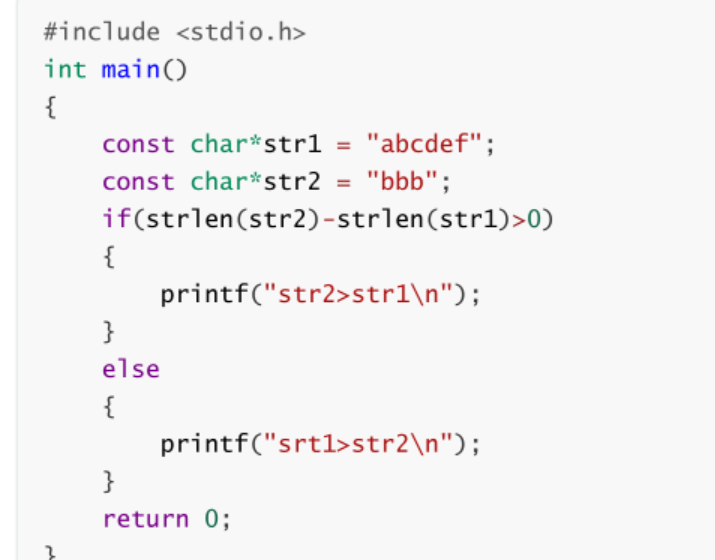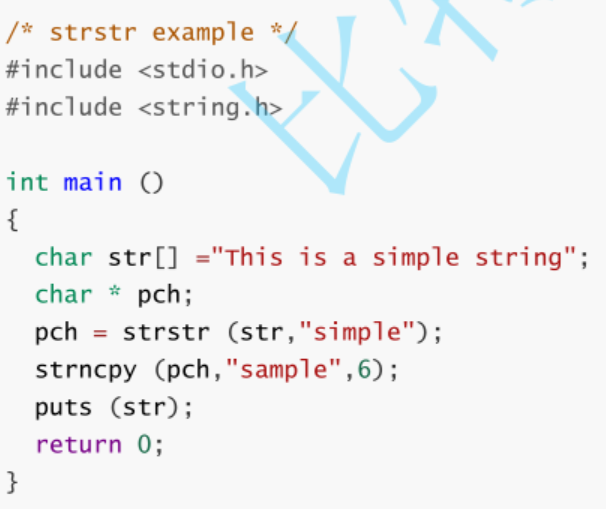1. 函数介绍
1.1 strlen
字符串已经 '\0' 作为结束标志,strlen函数返回的是在字符串中 '\0' 前面出现的字符个数(不包
含 '\0' )。
size_t strlen ( const char * str );
参数指向的字符串必须要以 '\0' 结束。
注意函数的返回值为size_t,是无符号的( 易错 )
学会strlen函数的模拟实现

1.2 strcpy
char* strcpy(char * destination, const char * source );
Copies the C string pointed by source into the array pointed by destination, including the
terminating null character (and stopping at that point).
源字符串必须以 '\0' 结束。
会将源字符串中的 '\0' 拷贝到目标空间。
目标空间必须足够大,以确保能存放源字符串。
目标空间必须可变。
学会模拟实现
1.3 strcat
char * strcat ( char * destination, const char * source );
Appends a copy of the source string to the destination string. The terminating null character
in destination is overwritten by the first character of source, and a null-character is included
at the end of the new string formed by the concatenation of both in destination.
源字符串必须以 '\0' 结束。
目标空间必须有足够的大,能容纳下源字符串的内容。
目标空间必须可修改。
字符串自己给自己追加,如何?
1.4 strcmp
int strcmp ( const char * str1, const char * str2 );
This function starts comparing the first character of each string. If they are equal to each
other, it continues with the following pairs until the characters differ or until a terminating
null-character is reached.
标准规定:
第一个字符串大于第二个字符串,则返回大于0的数字
第一个字符串等于第二个字符串,则返回0
第一个字符串小于第二个字符串,则返回小于0的数字
那么如何判断两个字符串?
1.5 strncpy
char * strncpy ( char * destination, const char * source, size_t num );
Copies the first num characters of source to destination. If the end of the source C string
(which is signaled by a null-character) is found before num characters have been copied,
destination is padded with zeros until a total of num characters have been written to it.
拷贝num个字符从源字符串到目标空间。
如果源字符串的长度小于num,则拷贝完源字符串之后,在目标的后边追加0,直到num个。
1.6 strncat

char * strncat ( char * destination, const char * source, size_t num );
Appends the first num characters of source to destination, plus a terminating null-character.
If the length of the C string in source is less than num, only the content up to the terminating
null-character is copied.
1.7 strncmp
char * strncpy ( char * destination, const char * source, size_t num );

/* strncat example */
#include <stdio.h>
#include <string.h>
int main ()
{
char str1[20];
char str2[20];
strcpy (str1,"To be ");
strcpy (str2,"or not to be");
strncat (str1, str2, 6);
puts (str1);
return 0;
}
1.8 strstr

Returns a pointer to the first occurrence of str2 in str1, or a null pointer if str2 is not part of
str1.

1.9 strtok

sep参数是个字符串,定义了用作分隔符的字符集合
第一个参数指定一个字符串,它包含了0个或者多个由sep字符串中一个或者多个分隔符分割的标
记。
/* strncmp example */
#include <stdio.h>
#include <string.h>
int main ()
{
char str[][5] = { "R2D2" , "C3PO" , "R2A6" };
int n;
puts ("Looking for R2 astromech droids...");
for (n=0 ; n<3 ; n++)
if (strncmp (str[n],"R2xx",2) == 0)
{
printf ("found %s\n",str[n]);
}
return 0;
}
char * strstr ( const char *str1, const char * str2);
/* strstr example */
#include <stdio.h>
#include <string.h>
int main ()
{
char str[] ="This is a simple string";
char * pch;
pch = strstr (str,"simple");
strncpy (pch,"sample",6);
puts (str);
return 0;
}
char * strtok ( char * str, const char * sep );
strtok函数找到str中的下一个标记,并将其用 \0 结尾,返回一个指向这个标记的指针。(注:
strtok函数会改变被操作的字符串,所以在使用strtok函数切分的字符串一般都是临时拷贝的内容
并且可修改。)
strtok函数的第一个参数不为 NULL ,函数将找到str中第一个标记,strtok函数将保存它在字符串
中的位置。
strtok函数的第一个参数为 NULL ,函数将在同一个字符串中被保存的位置开始,查找下一个标
记。
如果字符串中不存在更多的标记,则返回 NULL 指针。
1.10 strerror
返回错误码,所对应的错误信息。
/* strtok example */
#include <stdio.h>
#include <string.h>
int main ()
{
char str[] ="- This, a sample string.";
char * pch;
printf ("Splitting string \"%s\" into tokens:\n",str);
pch = strtok (str," ,.-");
while (pch != NULL)
{
printf ("%s\n",pch);
pch = strtok (NULL, " ,.-");
}
return 0;
}
#include <stdio.h>
int main()
{
char *p = "zhangpengwei@bitedu.tech";
const char* sep = ".@";
char arr[30];
char *str = NULL;
strcpy(arr, p);//将数据拷贝一份,处理arr数组的内容
for(str=strtok(arr, sep); str != NULL; str=strtok(NULL, sep))
{
printf("%s\n", str);
}
}
char * strerror ( int errnum );
/* strerror example : error list */
#include <stdio.h>
#include <string.h>
#include <errno.h>//必须包含的头文件
int main ()
{
函数 如果他的参数符合下列条件就返回真
iscntrl 任何控制字符
isspace 空白字符:空格‘ ’,换页‘\f’,换行'\n',回车‘\r’,制表符'\t'或者垂直制表符'\v'
isdigit 十进制数字 0~9
isxdigit 十六进制数字,包括所有十进制数字,小写字母a~f,大写字母A~F
islower 小写字母a~z
isupper 大写字母A~Z
isalpha 字母a~z或A~Z
isalnum 字母或者数字,a~z,A~Z,0~9
ispunct 标点符号,任何不属于数字或者字母的图形字符(可打印)
isgraph 任何图形字符
isprint 任何可打印字符,包括图形字符和空白字符
字符分类函数:
字符转换:
FILE * pFile;
pFile = fopen ("unexist.ent","r");
if (pFile == NULL)
printf ("Error opening file unexist.ent: %s\n",strerror(errno));
//errno: Last error number
return 0;
}
Edit & Run
int tolower ( int c );
int toupper ( int c );
/* isupper example */
#include <stdio.h>
#include <ctype.h>
int main ()
{
int i=0;
char str[]="Test String.\n";
char c;
while (str[i])
{
c=str[i];
if (isupper(c))
c=tolower(c);
putchar (c);
i++;
}
return 0;
1.11 memcpy
函数memcpy从source的位置开始向后复制num个字节的数据到destination的内存位置。
这个函数在遇到 '\0' 的时候并不会停下来。
如果source和destination有任何的重叠,复制的结果都是未定义的。
1.12 memmove
和memcpy的差别就是memmove函数处理的源内存块和目标内存块是可以重叠的。
如果源空间和目标空间出现重叠,就得使用memmove函数处理。
}
void * memcpy ( void * destination, const void * source, size_t num );
/* memcpy example */
#include <stdio.h>
#include <string.h>
struct {
char name[40];
int age;
} person, person_copy;
int main ()
{
char myname[] = "Pierre de Fermat";
/* using memcpy to copy string: */
memcpy ( person.name, myname, strlen(myname)+1 );
person.age = 46;
/* using memcpy to copy structure: */
memcpy ( &person_copy, &person, sizeof(person) );
printf ("person_copy: %s, %d \n", person_copy.name, person_copy.age );
return 0;
}
void * memmove ( void * destination, const void * source, size_t num );
1.13 memcmp
比较从ptr1和ptr2指针开始的num个字节
返回值如下:
2. 库函数的模拟实现
/* memmove example */
#include <stdio.h>
#include <string.h>
int main ()
{
char str[] = "memmove can be very useful......";
memmove (str+20,str+15,11);
puts (str);
return 0;
}
int memcmp ( const void * ptr1,
const void * ptr2,
size_t num );
/* memcmp example */
#include <stdio.h>
#include <string.h>
int main ()
{
char buffer1[] = "DWgaOtP12df0";
char buffer2[] = "DWGAOTP12DF0";
int n;
n=memcmp ( buffer1, buffer2, sizeof(buffer1) );
if (n>0) printf ("'%s' is greater than '%s'.\n",buffer1,buffer2);
else if (n<0) printf ("'%s' is less than '%s'.\n",buffer1,buffer2);
else printf ("'%s' is the same as '%s'.\n",buffer1,buffer2);
return 0;
2. 库函数的模拟实现
/* memmove example */
#include <stdio.h>
#include <string.h>
int main ()
{
char str[] = "memmove can be very useful......";
memmove (str+20,str+15,11);
puts (str);
return 0;
}
int memcmp ( const void * ptr1,
const void * ptr2,
size_t num );
/* memcmp example */
#include <stdio.h>
#include <string.h>
int main ()
{
char buffer1[] = "DWgaOtP12df0";
char buffer2[] = "DWGAOTP12DF0";
int n;
n=memcmp ( buffer1, buffer2, sizeof(buffer1) );
if (n>0) printf ("'%s' is greater than '%s'.\n",buffer1,buffer2);
else if (n<0) printf ("'%s' is less than '%s'.\n",buffer1,buffer2);
else printf ("'%s' is the same as '%s'.\n",buffer1,buffer2);
return 0;
}
2.1 模拟实现strlen
三种方式:
方式1:
方式2:
方式3:
2.2 模拟实现strcpy
参考代码:
//计数器方式
int my_strlen(const char * str)
{
int count = 0;
while(*str)
{
count++;
str++;
}
return count;
}
//不能创建临时变量计数器
int my_strlen(const char * str)
{
if(*str == '\0')
return 0;
else
return 1+my_strlen(str+1);
}
//指针-指针的方式
int my_strlen(char *s)
{
char *p = s;
while(*p != ‘\0’ )
p++;
return p-s;
}
//1.参数顺序
//2.函数的功能,停止条件
//3.assert
//4.const修饰指针
//5.函数返回值
//6.题目出自《高质量C/C++编程》书籍最后的试题部分
char *my_strcpy(char *dest, const char*src)
{
char *ret = dest;
assert(dest != NULL);
2.3 模拟实现strcat
参考代码:
2.4 模拟实现strstr
注:让他们下去自己研究一下KMP算法。
assert(src != NULL);
while((*dest++ = *src++))
{
;
}
return ret;
}
char *my_strcat(char *dest, const char*src)
{
char *ret = dest;
assert(dest != NULL);
assert(src != NULL);
while(*dest)
{
dest++;
}
while((*dest++ = *src++))
{
;
}
return ret;
}
char * strstr (const char * str1, const char * str2)
{
char *cp = (char *) str1;
char *s1, *s2;
if ( !*str2 )
return((char *)str1);
while (*cp)
{
s1 = cp;
s2 = (char *) str2;
while ( *s1 && *s2 && !(*s1-*s2) )
s1++, s2++;
if (!*s2)
return(cp);
cp++;
}
return(NULL);
2.5 模拟实现strcmp
参考代码:
2.6 模拟实现memcpy
参考代码:
2.7 模拟实现memmove
参考代码:
}
int my_strcmp (const char * src, const char * dst)
{
int ret = 0 ;
assert(src != NULL);
assert(dest != NULL);
while( ! (ret = *(unsigned char *)src - *(unsigned char *)dst) && *dst)
++src, ++dst;
if ( ret < 0 )
ret = -1 ;
else if ( ret > 0 )
ret = 1 ;
return( ret );
}
void * memcpy ( void * dst, const void * src, size_t count)
{
void * ret = dst;
assert(dst);
assert(src);
/*
* copy from lower addresses to higher addresses
*/
while (count--) {
*(char *)dst = *(char *)src;
dst = (char *)dst + 1;
src = (char *)src + 1;
}
return(ret);
}
void * memmove ( void * dst, const void * src, size_t count)
{
void * ret = dst;
if (dst <= src || (char *)dst >= ((char *)src + count)) {
/*
* Non-Overlapping Buffers
* copy from lower addresses to higher addresses
*/
while (count--) {
*(char *)dst = *(char *)src;
dst = (char *)dst + 1;
src = (char *)src + 1;
}
}
else {
/*
* Overlapping Buffers
* copy from higher addresses to lower addresses
*/
dst = (char *)dst + count - 1;
src = (char *)src + count - 1;
while (count--) {
*(char *)dst = *(char *)src;
dst = (char *)dst - 1;
src = (char *)src - 1;
}
}
return(ret);
}






















 1万+
1万+











 被折叠的 条评论
为什么被折叠?
被折叠的 条评论
为什么被折叠?








